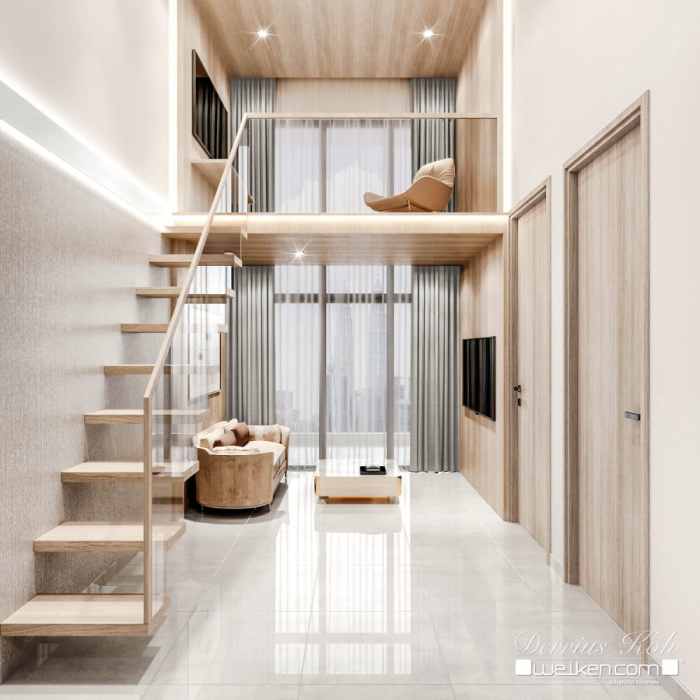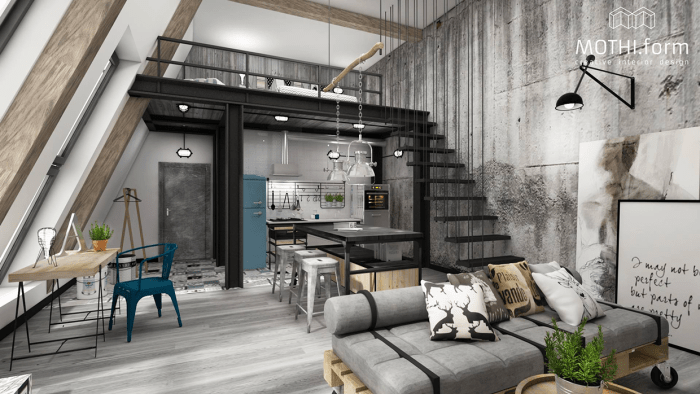Creating a Stylish Loft Interior Design: A Comprehensive Guide

Embark on a journey through the world of loft interior design, where urban chic meets modern elegance. From the industrial roots to contemporary trends, this guide delves into the essence of creating a captivating loft space that exudes style and sophistication.
Explore the key elements, color schemes, furniture choices, lighting designs, and space planning strategies that define the art of loft interior design.
Introduction to Loft Interior Design

Loft interior design is a style that emphasizes open spaces, high ceilings, exposed beams, and industrial elements. It often combines modern and vintage aesthetics to create a unique and trendy look.
Loft interior design originated in the 1940s in New York City when artists started converting old industrial spaces into living areas. It has since evolved to become a popular choice for urban dwellings seeking a sense of spaciousness and character.
Characteristics of Loft Interior Design
- Open floor plans that maximize space and natural light
- High ceilings with exposed beams and ductwork
- Industrial elements like brick walls, concrete floors, and metal fixtures
- Combination of modern and vintage furniture and decor
Benefits of Choosing Loft Interior Design
Loft interior design offers several advantages for both residential and commercial spaces:
- Creates a sense of spaciousness and airiness
- Allows for flexible layout and design possibilities
- Provides a unique and trendy aesthetic
- Emphasizes natural light and views
Elements of Loft Interior Design
Loft interior design is characterized by a few key elements that set it apart from other styles. These elements include:
Exposed Brick Walls
Exposed brick walls are a common feature in loft spaces, adding a touch of texture and history to the design. They can be incorporated as a focal point or used to create a rustic, industrial look.
Open Floor Plans
Open floor plans are essential in loft interior design, creating a sense of spaciousness and flow within the space. This layout allows for flexibility in furniture arrangement and promotes a modern, airy feel.
High Ceilings
High ceilings are another hallmark of loft design, providing an expansive atmosphere and allowing for unique lighting installations. They create a sense of grandeur and vertical space within the interior.
Industrial Materials
Industrial materials such as metal, concrete, and wood are often used in loft interiors to enhance the urban, raw aesthetic. These materials add character and authenticity to the space, reflecting the industrial history of lofts.
Comparison with Other Interior Design Styles
Loft interior design differs from traditional styles like minimalism or Scandinavian design by embracing raw, unfinished elements and a more eclectic mix of materials. While modern design focuses on clean lines and simplicity, loft design celebrates imperfections and industrial charm.
Incorporating Elements into a Modern Loft Space
- Use pendant lighting to highlight high ceilings and create a dramatic focal point.
- Combine sleek, modern furniture with industrial accents like exposed ductwork or metal shelving.
- Integrate natural elements like plants or wooden accents to soften the industrial feel and add warmth to the space.
- Create a cohesive color palette with neutral tones and pops of bold colors to balance the raw materials and textures.
- Accessorize with vintage finds or unique artwork to personalize the space and add personality.
Color Schemes and Textures in Loft Interior Design
When it comes to loft interior design, choosing the right color schemes and textures can significantly impact the overall look and feel of the space. Colors and textures can help create a cozy and inviting atmosphere, making the loft a comfortable place to live in.
Popular Color Schemes in Loft Interior Design
- Neutral Tones: Shades of white, beige, gray, and cream are often used in loft interiors to create a clean and airy ambiance.
- Industrial Colors: Deep tones like charcoal, navy, and black can add a touch of sophistication and edginess to the space, complementing the industrial aesthetic of lofts.
- Vibrant Accents: Splashes of bold colors like red, yellow, or teal can be incorporated through furniture, artwork, or accessories to add personality and visual interest to the design.
Role of Textures in Loft Interior Design
Textures play a crucial role in adding depth and dimension to a loft space. Mixing different textures such as rough brick walls, sleek metal finishes, soft fabrics, and natural wood elements can create a visually dynamic and tactile experience. Textures also help in making the space feel warmer and more inviting.
Tips for Balancing Colors and Textures
- Choose a dominant color as a base and then add pops of contrasting colors for visual interest.
- Balance rough textures with smooth ones to create a harmonious look and feel in the space.
- Consider the natural light in the loft when selecting colors and textures, as they can appear differently under various lighting conditions.
- Use rugs, throw pillows, and curtains to introduce different textures and colors without overwhelming the space.
- Experiment with different combinations of colors and textures to find a balance that reflects your personal style and creates a cozy atmosphere in your loft.
Furniture and Decor for Loft Spaces
When it comes to furnishing and decorating a loft space, it's essential to choose pieces that not only complement the industrial aesthetic but also maximize the open layout and high ceilings typical of lofts. Let's delve into the different furniture styles and decor elements that work well in loft interior design.
Complementary Furniture Styles
- Minimalist Style: Opt for sleek, simple furniture with clean lines to maintain the spacious feel of a loft.
- Industrial Style: Consider incorporating metal, wood, and raw materials to enhance the urban, industrial look of a loft.
- Mid-Century Modern: Embrace the retro yet timeless appeal of mid-century modern furniture pieces for a stylish contrast in a loft setting.
Choosing the Right Furniture Pieces
- Scale and Proportion: Select furniture that fits the scale of the space and complements the height of loft ceilings.
- Multi-functional Pieces: Opt for furniture that serves dual purposes, such as storage ottomans or convertible sofa beds, to maximize functionality in a loft.
- Statement Pieces: Incorporate unique furniture items like a bold accent chair or a vintage coffee table to add personality and visual interest to the space.
Enhancing with Decor Accessories
- Rugs: Add warmth and texture to the industrial look of a loft with area rugs that define different zones within the open space.
- Lighting Fixtures: Use statement lighting pieces like pendant lights or exposed bulbs to create a dramatic ambiance and highlight the lofty ceilings.
- Artwork: Display large-scale art pieces or gallery walls to inject color and character into the neutral backdrop of a loft interior.
Lighting Design in Loft Interiors

Lighting plays a crucial role in setting the ambiance and highlighting the unique features of a loft space. It can enhance the overall design aesthetic and functionality of the area.
Types of Lighting Fixtures for Loft Interior Design
- 1. Pendant Lights: These hanging fixtures are great for providing focused task lighting over dining tables or kitchen islands.
- 2. Track Lighting: Ideal for highlighting specific areas or artworks in the loft, track lighting offers flexibility in directing light.
- 3. Floor Lamps: Floor lamps can add both ambient and task lighting while also serving as decorative elements in the space.
- 4. Wall Sconces: These fixtures can create a warm and inviting atmosphere, especially when placed strategically along walls or hallways.
Tips for Maximizing Natural Light and Artificial Lighting
Maximizing natural light in a loft can help reduce the need for artificial lighting during the day, creating a more sustainable and energy-efficient space. Here are some tips:
- 1. Keep windows unobstructed: Avoid blocking windows with heavy drapes or furniture to allow natural light to flow freely into the space.
- 2. Use light-colored walls and reflective surfaces: Light-colored walls and mirrors can help bounce natural light around the room, making it feel brighter and more spacious.
- 3. Strategic placement of artificial lighting: Place lighting fixtures strategically to eliminate dark corners and create a balanced lighting scheme throughout the loft.
- 4. Layer lighting: Combine different types of lighting (ambient, task, accent) to create depth and visual interest in the space.
Space Planning and Layout for Lofts

When it comes to loft interiors, optimizing space is crucial due to the open layout characteristic of these spaces. Efficient space planning can make a significant difference in both the functionality and aesthetics of a loft.
Maximizing Space in a Loft
- Utilize multi-functional furniture pieces such as sofa beds, storage ottomans, and foldable tables to save space.
- Use room dividers like bookshelves or curtains to create separate zones within the open layout.
- Consider vertical storage solutions to make the most of the height in a loft, such as tall shelves or hanging organizers.
Room Zoning in a Loft Setting
- Define different areas for specific purposes like living, dining, working, and sleeping to establish a sense of organization.
- Use area rugs or lighting fixtures to visually delineate separate zones within the open space.
- Opt for furniture placement that allows for easy circulation and clear pathways between different areas.
Creating Functional and Visually Appealing Spaces
- Balance the layout with a mix of open and closed storage options to maintain a clean and organized look.
- Incorporate mirrors to enhance natural light and create an illusion of more space in a loft.
- Choose furniture pieces that complement the industrial aesthetic of loft interiors while adding a touch of warmth and comfort.
Ending Remarks
In conclusion, loft interior design offers a unique blend of history, creativity, and functionality. By incorporating the right elements and design principles, you can transform any space into a trendy loft haven that reflects your personal style. Elevate your living experience with the timeless allure of loft interior design.
FAQ Resource
What defines loft interior design?
Loft interior design is characterized by open floor plans, high ceilings, industrial materials, and a blend of modern and urban aesthetics.
How can I incorporate industrial elements into a modern loft space?
You can add exposed brick walls, metal fixtures, and reclaimed wood furniture to infuse industrial charm into your loft design.
What are popular color schemes for loft interiors?
Neutral tones like gray, white, and black are commonly used in loft interior design to create a contemporary and versatile backdrop.
What furniture styles complement loft interior design?
Minimalist, industrial, and mid-century modern furniture styles are ideal choices to enhance the loft aesthetic and maximize space.
How important is lighting in loft interiors?
Lighting plays a vital role in creating ambiance and highlighting architectural features in a loft space, making it crucial for a well-designed interior.

